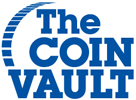The precious metals market is constantly changing. Every minute on the minute, prices either increase or decrease and sometimes, those adjustments do so in big ways. While the current market has recently seen an upward trend, especially when gold hit its highest price ever in history, only time will tell if the trend will stick or curve either direction. When gold and silver prices increase, so does the demand. When it comes to demand though, collector edition coins do not always follow the trend. This is even more so true when metal prices go down. Precedence for this fact has already been set dating back to the mid-1990s and through 2001.
While Proof versions of our favorite coins like the American Silver Eagles and Gold Eagles are often collected and revered, they are not always the first choice when the metals market changes. The next coin to break down in our 100 Greatest Modern United States Coins series is one of those examples. With influence from some of the top coin dealers from across the country, authors Scott Schechter and Jeff Garrett put this coin in the middle of the pack in Whitman Publishing’s fourth edition of the publication.
#51 - 2001-W $50 American Gold Eagle, Proof
When gold prices go down, collector interests in coins like the Proof American Gold Eagles also go down. While investors may see the decline as a buying opportunity, collectors opt-out completely due to the coins trading at discounts lower than what they originally paid for from the United States Mint. This fact became especially true of the Proof Gold American Eagles when gold continued to decrease in the mid-1990s through 2001.
In response to the slow decline in gold prices, the Mint decided to lower the issue price of the one-ounce $50 Proof American Gold Eagle in 1998 from $589 to $570. This price compared to the price in 1990. In addition to lowering the price to help customers out, they also lowered the maximum mintage from 45,000 to 35,000 to appeal to customers who looked at mintage limits. Buyers only responded slightly to the lowered price and mintage. Something worth mentioning in this particular moment, authors Schechter and Garrett note that while the Mint lowered their issue price of the coin to that of the 1990 price, gold market-wise was hovering around $400 an ounce. In 1998, it was hovering around just $300 per ounce. Overall, if the issue price of the $50 Proof Gold Eagle had been adjusted in 1998 when the Mint made a push to appeal to more collectors, the sales would have increased accordingly.
In 1999, 2000, and 2001, the issue prices remained the same and the maximum mintages only slightly increased to 40,000 in 1999 and 41,000 in 2000 and 2001. However, the metal only continued to decrease to around $260 per ounce and the Mint decided to keep the prices the same. This meant that when it came to wholesale prices, the Proof Gold American Eagle was still $150-$200 above the per-ounce price of gold even though it was still between $100 to $150 lower than the Mint’s issue price. The unwillingness to change prices according to the market decline led to collectors throwing up their hands in defeat. For the 2001-W $50 Proof Gold Eagle, only 24,555 were sold and it became the lowest in the coin’s history that began in 1986.
The values of gold slightly increased the next year in 2002 and continued to do so each following year. This left the 2001 issue the lowest of the one-ounce $50 Proof American Gold Eagles. The Mint only revised its plan to price coins according to the change in the precious metals market beginning in 2009.
This coin has remained steady in its rankings throughout the four editions of these publications. It started at #50 in this first edition and has only gone down one spot.
